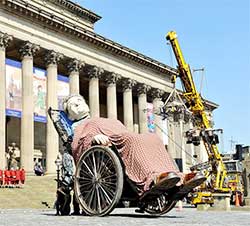Four days of amazing public theatre saw the return of the Royal De Luxe giant marionettes to Liverpool for a weekend of fun, history, poignancy and superlative entertainment. Adlib, also of Liverpool, was at the heart of the action providing sound reinforcement systems throughout the city.
The show “Memories of August 1914”, designed to commemorate the centenary anniversary of the start of World War I, also highlights the heroic Liverpool Pals who answered Lord Kitchener’s call for volunteer recruits.
The event pulled an estimated one million people into downtown Liverpool for one of the most successful public arts events staged in the UK.
The Liverpool City Council tapped Adlib to provide sound systems for the main seven performance sites located around the city centre.
The different sites all accommodated large crowds between 10,000 and 40,000. The sound systems were designed to ensure that everyone in the crowd could hear the performance soundtrack clearly as the Royal De Luxe giant marionettes moved around the city – telling their story along a carefully choreographed route.
The operation was co-ordinated by Adlib Director Phil Stoker and involved 16 Adlib technicians. Stoker worked closely with the event’s Production Manager Stu Stalker and Production Assistant Jonathan Sims.
The various audio systems – all based around L-Acoustics or Coda elements – were co-designed by Adlib’s Tony Szabo and Royal De Luxe’s Sound Designer, Stephane Brosse.
The seven sites were St George’s Hall, Newsham Park, Mann Island, Canning Dock, Clarence Dock, the Metropolitan Cathedral and the Queensway Tunnel. Oftentimes the systems were de-rigged from one and had to leapfrog ahead of the procession in order to be set up in the next location.
At St George’s Hall, Adlib installed an L-Acoustics K2 system comprised of left-right line arrays (11 loudspeakers each) flown off Adlib’s new Prolyte PA towers, complete with Lake processing / control and a Soundcraft Vi1 console.
At Newsham Park, one of the largest sites for audience numbers, attracting crowds of around 40,000, Adlib installed two hangs of L-Acoustics K1 (10 enclosures each) flown off 40-ton tower cranes and more Lake/Soundcraft control.
Clarence Dock was catered for with another K1 system on cranes and attracted another 10,000 people.
For the three sites at Mann Island, the Metropolitan Cathedral and Queensway Tunnel, all the PAs were deployed on the back of two flatbed Hiab crane trucks for quick setup. They arrived on the sites and elevated the PA arrays just ahead of the Giants arriving to play out their scene. These Hiabs were each loaded with 12 x Coda LA12 speakers, complete with Soundcraft SI compact mixers.
In all cases the audio signals from the music / band truck accompanying the giant marionette cast of three characters – the Little Girl, the Grandmother and Xolo the dog —were beamed via RF link over to the Adlib systems at each of the stopping points.
For the finale at Canning Dock, the entire waterfront was closed and the Giants moved onto the water in boats, which sailed off down the Mersey River in a wave of smoke and high emotion.
The Canning dock entailed a fast set up of a line array of 20 K1 enclosures from a 3 axle mobile tower crane. The array was then hung at the edge of the water so it would throw across the water to the road – which was 100m to the first person and 130m to the last – that was just directly in front.
The side coverage was 180m to the first person. The setup needed to be completed in four hours starting with when the crane arrived on the site. The soundtrack was mixed through one of Adlib’s DiGiCo SD10 consoles.
Phil Stoker states, “As a Liverpool company, we were all extremely proud to be part of this event which did so much to capture the public imagination and I’m sure inspire many people who might not go to a conventional theatre show … to be part of the performance”.
He adds that it wasn’t so much the actual sound systems that were the challenge in this case, it was “the logistics that were the galvanising part”.
This was challenging in terms of the time needed to build the systems, use the system, de-rig and then travel to the next site to do it all over again.
“Our crew were fantastic as always and really embraced the unique atmosphere, spirit and community of the occasion,” he says. “We could all appreciate what an historic opportunity it was, to assist people in enjoying the City and all it has to offer”.




















